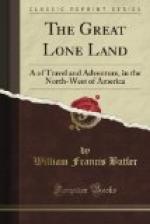prisoner named Thomas Scott. This act, committed
in the coldest of cold blood, bears only one name:
the red name of murder-a name which instantly and for
ever drew between Riel and his followers, and the
outside Canadian world, that impassable gulf which
the murderer in all ages digs between himself and society,
and which society attempts to bridge by the aid of
the gallows. It is needless here to enter into
details of this matter; of the second rising which
preceded it; of the dead blank which followed it; of
the heartless and disgusting cruelty which made the
prisoners death a foregone conclusion at his mock
trial; or of the deeds worse than butchery which characterized
the last scene. Still, before quitting the revolting
subject, there is one point that deserves remark, as
it seems to illustrate the feeling entertained by
the leaders themselves. On the night of the murder
the body was interred in a very deep hole which had
been dug within the walls of the fort. Two clergymen
had asked permission to inter the remains in either
of their churches, but this request had been denied.
On the anniversary of the murder, namely, the 4th March,
1871, other powers being then predominant in Fort Garry,
a large crowd gathered at the spot where the murdered
man had been interred, for the purpose of exhuming
the body. After digging for some time they came
to an oblong box or coffin in which the remains had
been placed, but it was empty, the interment within
the walls had been a mock ceremony, and the final
resting-place of the body lies hidden in mystery.
Now there is one thing very evident from the fact,
and that is that Riel and his immediate followers
were themselves conscious of the enormity of the deed
they had committed, for had they believed that the
taking of this man’s life was really an execution
justified upon any grounds of military or political
necessity, or a forfeit fairly paid as price for crimes
committed, then the hole inside the gateway of Fort
Garry would have held its skeleton, and the midnight
interment would not have been a senseless lie.
The murderer and the law both take life—it
is only the murderer who hides under the midnight
shadows the body of his victim.
CHAPTER FOUR.
Chicago—“Who is S. B. D.?”—Milwaukie—The
Great Fusion-Wisconsin—The Sleeping-car—The
Train Boy-Minnesota—St. Paul—I
start for Lake Superior—The Future City—“Bust
up” and “Gone on”—The
End of the Track.
Alas! I have to go a long way back to the
city of Toronto, where I had just completed the purchase
of a full costume of a Western borderer. On the
10th of June I crossed the Detroit River from Western
Canada to the State of Michigan, and travelling by
the central railway of that state reached the great
city of Chicago on the following day. All Americans,
but particularly all Western Americans, are very proud
of this big city, which is not yet as old as many
of its inhabitants, and they are justly proud of it.
It is by very much the largest and the richest of the
new cities of the New World. Maps made fifty
years ago will be searched in vain for Chicago.
Chicago was then a swamp where the skunks, after whom
it is called, held undisputed revels. To-day Chicago
numbers about 300,000 souls, and it is about “the
livest city in our great Republic; sir.”




